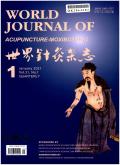Effects of acupuncture on iron metabolism in the hippocampus of the rats with cerebral ischemia-reperfusion injury based on the imbalance of iron homeostasis
IF 1.3
4区 医学
Q4 INTEGRATIVE & COMPLEMENTARY MEDICINE
引用次数: 0
Abstract
Objective
This study aimed to observe the effects of acupuncture on iron metabolism in the hippocampus of rats with cerebral ischemia-reperfusion injury (CIRI) and to explore the mechanism of acupuncture on neural repair in CIRI rats.
Methods
After general feeding for 3 days, 16 of 48 healthy Sprague–Dawley rats were selected according to a random number table to form a sham-occlusion group, and the models were prepared in the remaining rats. After successful modeling, the rats were randomized into model and acupuncture groups, with 16 rats in each group. The CIRI models were prepared using the modified Zea Longa suture-occlusion method. In the acupuncture group, the rats were fixed and acupuncture was delivered at “Shuigou” (GV26), “Dazhui” (GV14), and “Baihui” (GV20), and the needles were manipulated once every 15 min. In the sham-occlusion and model groups, rats were fixed without acupuncture. The intervention was performed for 30 min in each group, once every 12 h, seven times. The degree of neurological impairment was assessed by using the modified Garcia score. Cerebral blood flow (CBF) was monitored using a laser speckle blood flow imaging system. The cerebral infarction area ratio was measured using triphenyltetrazolium chloride staining. Ferric ion aggregation in brain tissue was noted using Prussian blue staining. The ferric ion and glutathione (GSH) contents of the hippocampal tissue on the ischemic side were detected using ferric ion and GSH kits. The protein expression of transferrin receptor 1 (TFR1), iron regulatory protein 2 (IRP2), and ferroportin (FPN) was detected via western blotting.
Results
(1) Before intervention, compared with the sham-occlusion group, the Garcia neurological score was significantly reduced in the model and acupuncture groups (both P < 0.01). After the intervention, compared with the sham-occlusion group, the Garcia neurological score in the model group decreased significantly (P < 0.01), and the score in the acupuncture group was elevated compared with the model group (P < 0.05). Compared to before the intervention, the Garcia neurological score increased after the intervention in the acupuncture group (P < 0.05). (2) Compared with the sham-occlusion group, in the model group, CBF was reduced, the infarct area was significantly enlarged, ferric ion aggregation increased in the hippocampus, the content of ferric ion increased, and that of GSH decreased significantly (both P < 0.01), while the protein expression of TFR1 and IRP2 was upregulated and that of FPN was downregulated (both P < 0.05). When compared with the model group, in the acupuncture group, CBF was increased, the infarct area was reduced (P < 0.01), the ferric ion aggregation was reduced in the hippocampus, the content of ferric ion decreased, and that of GSH increased significantly (P < 0.05, P < 0.01); the protein expression of TFR1 and IRP2 was downregulated and that of FPN was upregulated (both P < 0.05).
Conclusion
Acupuncture can alleviate CIRI, which may be related to the regulation of iron homeostasis-associated transferrin in the hippocampus, attenuation of ferric ion aggregation in hippocampal tissue, reduction of lipid peroxidation, and inhibition of ferroptosis.
基于铁稳态失衡针刺对脑缺血再灌注损伤大鼠海马铁代谢的影响
目的观察针刺对脑缺血再灌注损伤大鼠海马铁代谢的影响,探讨针刺对脑缺血再灌注损伤大鼠神经修复的作用机制。方法正常饲养3 d后,按随机数字表法从48只健康大鼠中选择16只组成假牙合组,其余大鼠制备模型。造模成功后,将大鼠随机分为模型组和针刺组,每组16只。采用改良的Zea - Longa缝合-闭塞法制备CIRI模型。针刺组固定大鼠,在“水沟”(GV26)、“大椎”(GV14)、“百会”(GV20)处针刺,每15 min操作1次。假牙合组和模型组固定大鼠,不针刺。每组干预30 min,每12 h干预1次,共7次。采用改良的加西亚评分法评估神经损伤程度。采用激光散斑血流成像系统监测脑血流(CBF)。采用氯化三苯四唑染色法测定脑梗死面积比。普鲁士蓝染色观察脑组织铁离子聚集。采用铁离子和谷胱甘肽试剂盒检测缺血侧海马组织铁离子和谷胱甘肽(GSH)含量。western blotting检测转铁蛋白受体1 (TFR1)、铁调节蛋白2 (IRP2)、运铁蛋白(FPN)蛋白表达。结果(1)干预前,与假牙阻断组比较,模型组和针刺组的Garcia神经评分均显著降低(P <;0.01)。干预后,与假牙组比较,模型组的Garcia神经学评分明显降低(P <;0.01),针刺组与模型组比较评分升高(P <;0.05)。与干预前比较,针刺组干预后加西亚神经学评分增高(P <;0.05)。(2)与假牙闭塞组比较,模型组大鼠脑血流减少,梗死面积明显增大,海马铁离子聚集增加,铁离子含量增加,GSH含量显著降低(P <;0.01),而TFR1和IRP2蛋白表达上调,FPN蛋白表达下调(P <;0.05)。与模型组比较,针刺组脑血流增大,梗死面积减小(P <;0.01),海马铁离子聚集减少,铁离子含量降低,谷胱甘肽含量显著升高(P <;0.05, P <;0.01);TFR1和IRP2蛋白表达下调,FPN蛋白表达上调(P <;0.05)。结论针刺可减轻CIRI,其机制可能与调节海马铁稳态相关转铁蛋白、减弱海马组织铁离子聚集、减少脂质过氧化、抑制铁下垂有关。
本文章由计算机程序翻译,如有差异,请以英文原文为准。
求助全文
约1分钟内获得全文
求助全文
来源期刊

World Journal of Acupuncture-Moxibustion
INTEGRATIVE & COMPLEMENTARY MEDICINE-
CiteScore
1.30
自引率
28.60%
发文量
1089
审稿时长
50 days
期刊介绍:
The focus of the journal includes, but is not confined to, clinical research, summaries of clinical experiences, experimental research and clinical reports on needling techniques, moxibustion techniques, acupuncture analgesia and acupuncture anesthesia.
 求助内容:
求助内容: 应助结果提醒方式:
应助结果提醒方式:


